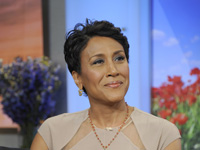AARP Eye Center
Donors Wanted: Robin Roberts Helps Push Bone Marrow Donation
By Candy Sagon, June 12, 2012 02:13 PM

ABC News' Robin Roberts, 51, who announced she will undergo a bone marrow transplant this fall to fight a rare blood disorder, was fortunate that her older sister, Sally Ann, was the perfect match to donate marrow -- the only treatment for Roberts' myelodysplastic syndrome (MDS), a type of pre-leukemia.
Both women know that many patients don't have a family member who is eligible, and they are encouraging everyone to sign up with Be The Match, an organization that helps match marrow donors to recipients.
In a letter to viewers, Roberts said that organ donors were vitally important and that many people didn't realize they can be bone marrow donors or how easy it is to become one.
A health history and a swab for cheek cells is all it takes to register as a donor. If you are a match for a patient, donating marrow is an out-patient procedure similar to donating blood.
More than 10,000 Americans are diagnosed annually with blood cancers such as leukemia or lymphoma and other life-threatening diseases and their best or only hope for a cure is a bone marrow transplant.
Unfortunately, 70 percent of patients needing a transplant do not have a matching donor in their family, according to Be The Match. Instead, they'll depend on an unrelated adult donor or cells from donated umbilical cord blood.
To become a donor, CEO Jeffrey Chell, M.D., of Be The Match says people need to be healthy and between the ages of 18 to 60, although younger donors -- between 18 and 44 -- are especially needed. Research shows that cells from younger donors lead to more successful transplants.
Chell notes that some health conditions could prevent an individual from donating, including HIV, AIDS; organ or tissue transplant; severe heart disease; and most forms of cancer except for skin and cervical cancer in situ. To sign up for a registration kit from Be The Match Registry, click here.
Roberts was especially lucky because there aren't enough African-American marrow donors registered, says Be The Match. The organization hopes the publicity over Roberts' condition will encourage more African-American donors to join the registry.
Roberts, who was also a breast cancer survivor, is among the 1 to 2 percent of cancer patients who develop MDS, a blood disorder brought on by the treatments used to kill the breast cancer.
Oncologist David Steensma, who treats MDS patients at the Dana Farber Cancer Institute in Boston, told the Boston Globe that both chemotherapy and radiation treatments can irreversibly damage the DNA of the bone marrow cells, leading to a rise in new cancers.
The astronomer Carl Sagan died of MDS, as did writers Susan Sontag and Roald Dahl after their cancer treatments.
Steensma said MDS has only a 20 percent cure rate, but that younger adults, such as the 51-year-old Roberts, have higher cure rates, in the 30 to 40 percent range.
Photo credit: Ida Mae Astute/ABC/AP Photo























































